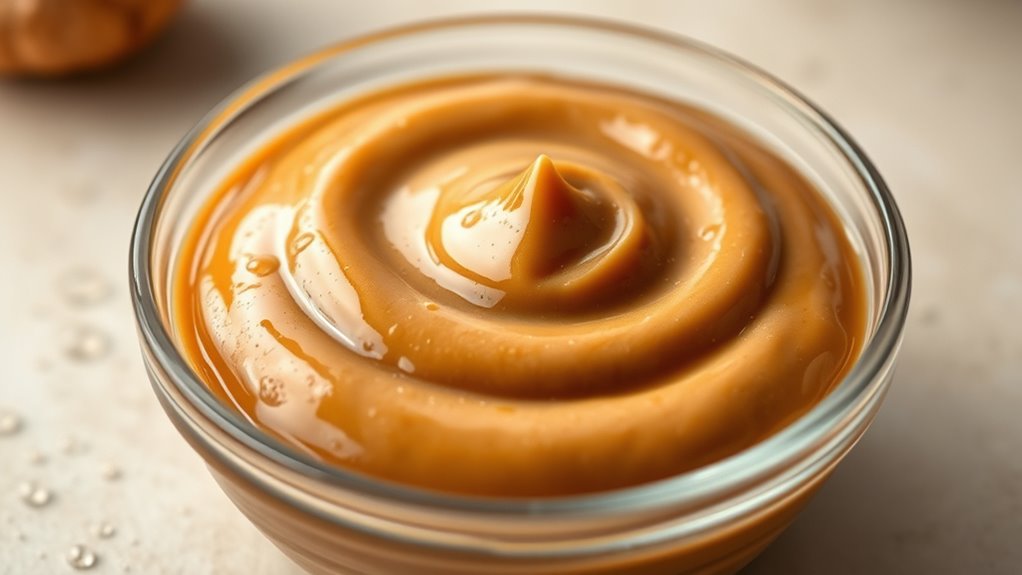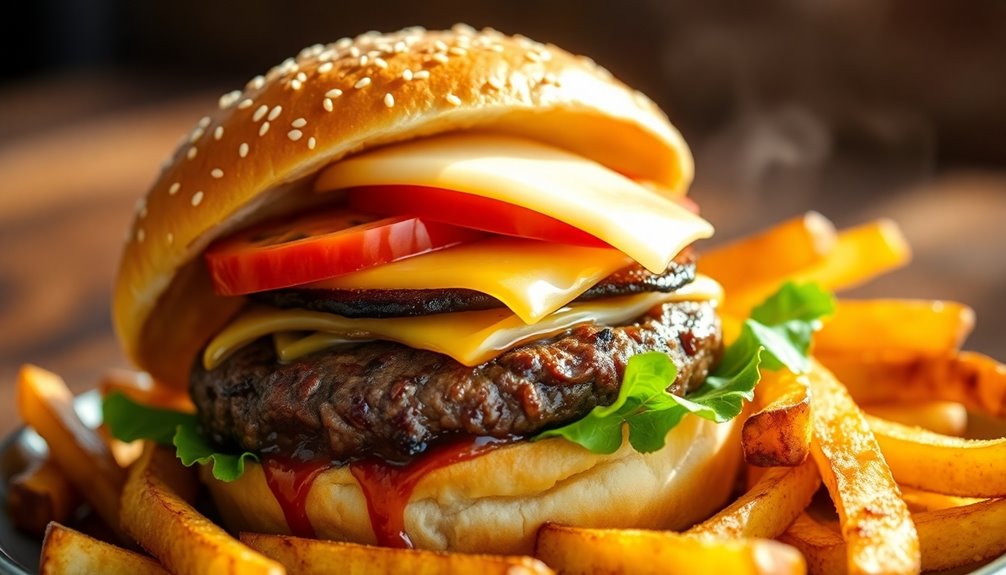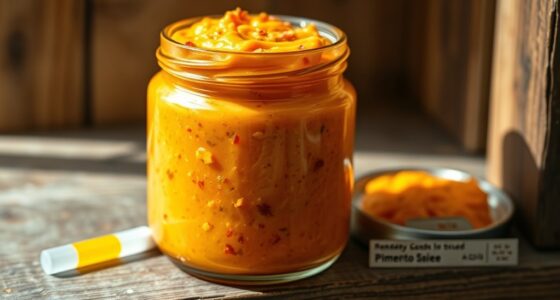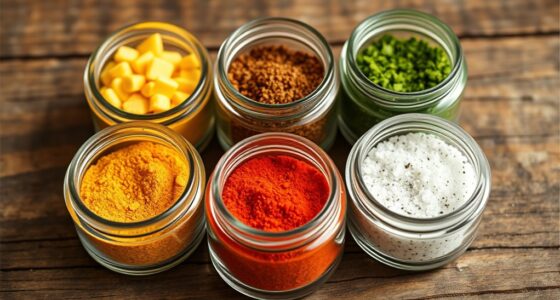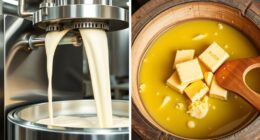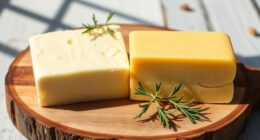To test the emulsion stability of your savory peanut butter dip, thoroughly mix your ingredients and seal them in a clean jar. Let it sit at room temperature for a set period, then invert or shake the jar to check for oil separation. Minimal separation means a stable emulsion. If you keep experimenting, you’ll discover how ingredient quality and mixing techniques can improve your dip’s texture and appearance even further.
Key Takeaways
- Ensure thorough blending of peanut butter with liquids like soy sauce and lime juice for a stable emulsion.
- Gradually add liquids while mixing to promote even dispersion and prevent separation.
- Seal and invert the jar after resting to observe any oil separation, indicating emulsion stability.
- Use room temperature ingredients to enhance blending and reduce the risk of separation.
- Adjust ingredient ratios, such as adding a small amount of oil or vinegar, to improve overall stability.
Understanding Emulsion Stability in Savory Peanut Butter Dips
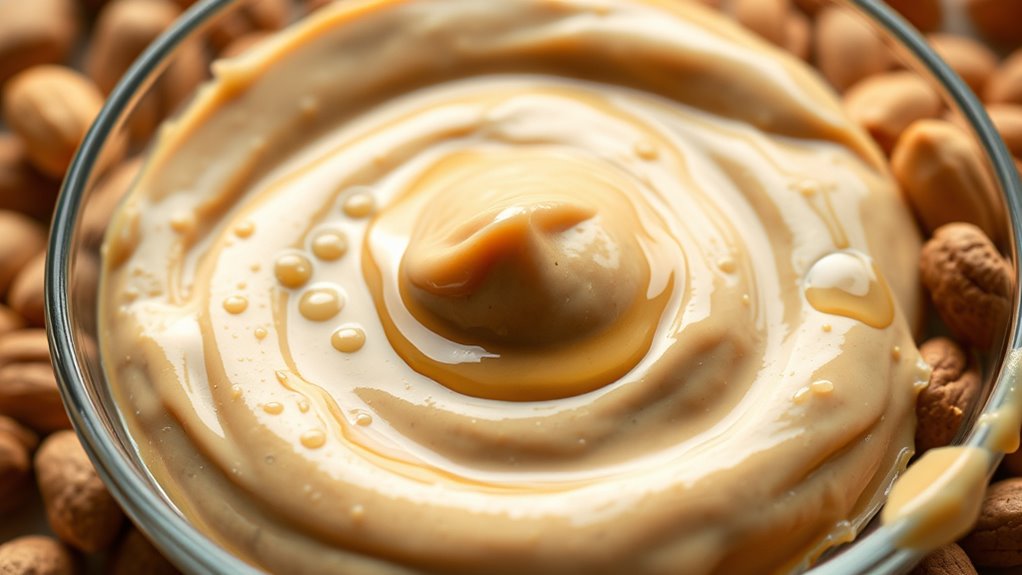
Understanding emulsion stability in savory peanut butter dips is essential because it determines how well the ingredients combine and stay mixed over time. When the emulsion is unstable, oil separation becomes noticeable, and the dip can quickly develop an unappetizing surface layer. Emulsion breakdown occurs when the mixture’s stabilizers fail, causing the oil and water components to separate. This instability affects texture, appearance, and overall flavor. To prevent oil separation, you need to comprehend the factors that influence emulsion stability, such as the type of emulsifiers used and mixing techniques. Keeping the emulsion stable ensures your dip maintains a creamy consistency and looks appealing, making it more enjoyable to serve and eat. Recognizing signs of emulsion breakdown helps you adjust ingredients or methods promptly. Proper mixing techniques also play a crucial role in maintaining emulsion stability by ensuring even distribution of stabilizers.
Ingredients and Preparation for the Test

To guarantee your savory peanut butter dip turns out perfectly, start by gathering high-quality ingredients. Choose your peanut butter varieties carefully—smooth, crunchy, or flavored—based on your texture and flavor preferences. For consistency, opt for natural, unsweetened options, but feel free to experiment with roasted or honey-roasted varieties. When preparing, combine peanut butter with ingredients like soy sauce, garlic, and lime juice for a balanced taste. You can also make ingredient substitutions—such as swapping tahini for part of the peanut butter or using different vinegars—to customize the flavor profile. Use fresh, quality herbs and seasonings to enhance the dip’s complexity. Proper preparation involves blending until smooth, ensuring the emulsion forms evenly for a stable, flavorful dip. Additionally, understanding emulsion stability can help you achieve a more consistent and appealing texture in your dip.
Conducting the Emulsion Stability Experiment
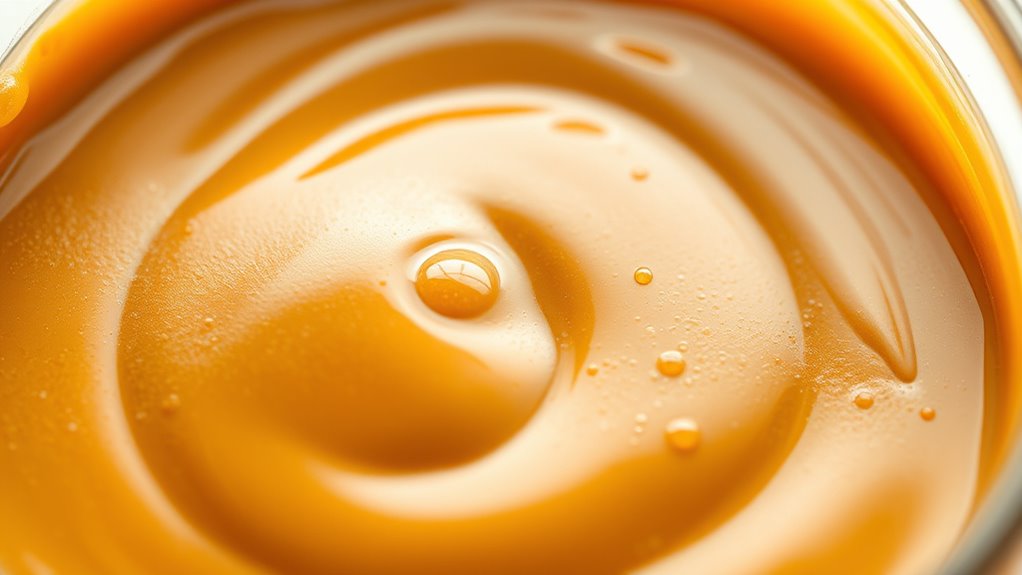
Before testing the stability of your peanut butter emulsion, gather the necessary tools and ingredients. Use a clean jar or container with a lid, a spoon or whisk for mixing, and a timer. Make sure your ingredient ratios are precise, with the correct amounts of peanut butter, oil, and liquids. Mix everything thoroughly to form the emulsion, then seal the container. Place it in a stable environment at room temperature. After a set period, gently invert or shake the jar and observe for oil separation or layer formation. Consistent ingredient ratios help maintain emulsion stability, so note any oil separation that occurs. This step allows you to evaluate how well your mixture holds together, providing a baseline for understanding its emulsion stability.
Analyzing Results and Identifying Factors Affecting Stability
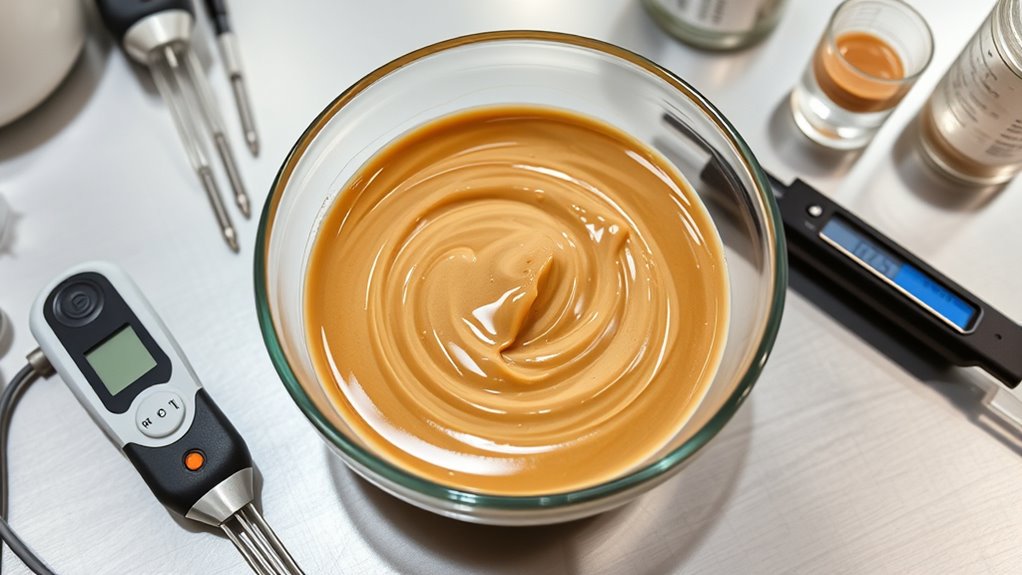
Once you’ve completed the emulsion stability experiment, carefully examine the observations to determine how well your mixture held together. Look for signs like minimal oil separation or a uniform texture, indicating good stability. Factors affecting stability often include ingredient interactions; for example, the balance between peanut butter, oil, and stabilizers is vital. Poor ingredient interactions can lead to increased oil separation, causing the dip to break or become gritty. Use this table to analyze your results:
| Observation | Possible Cause | Action Needed |
|---|---|---|
| Oil separation present | Weak emulsifier or improper mixing | Add more stabilizer or remix |
| Smooth, uniform dip | Strong ingredient interactions | Maintain current recipe |
| Gritty texture | Insufficient emulsification | Blend longer or adjust ingredients |
Additionally, understanding the role of emulsion stability in the overall quality can help optimize your recipe.
Tips for Improving Emulsion Stability in Your Dip

Improving emulsion stability in your peanut butter dip often involves making small adjustments to your ingredients and mixing techniques. To enhance texture, consider gradually adding liquids while mixing to create a smoother, more cohesive consistency. Incorporate a small amount of oil or vinegar to help stabilize the emulsion, which also aids in flavor balancing. Using room temperature ingredients ensures better blending and reduces separation risk. Additionally, adding a pinch of salt or a splash of lemon juice can improve flavor harmony without destabilizing the mixture. Whisking thoroughly and consistently is key to preventing separation and achieving a creamy texture. Incorporating mindfulness and patience during the mixing process can also foster a more stable emulsion by controlling the environment, leading to a more satisfying final result. These tips help you create a dip that’s not only stable but also rich in balanced flavor and inviting texture.
Frequently Asked Questions
How Long Can a Savory Peanut Butter Dip Stay Fresh Before Separation Occurs?
Your savory peanut butter dip typically stays fresh for about 3 to 5 days if you keep it refrigerated. To maintain its ingredient freshness and prevent separation, make sure to store it in an airtight container. After this period, separation may occur, indicating the dip’s shelf life has ended. For best results, give it a good stir before using, and always check for any off smells or changes in texture.
What Are Common Signs Indicating a Failed Emulsion in the Dip?
When your emulsion fails, you’ll notice clear signs like oil separation on the surface and a noticeable texture change, making the dip appear gritty or watery. These signs indicate the emulsion has broken down, and the ingredients are no longer stable. If you observe these changes, it’s best to stir the dip thoroughly or consider re-emulsifying it with a bit of water or oil to restore its original consistency and prevent spoilage.
Can Alternative Oils Enhance Emulsion Stability in Peanut Butter Dips?
Ah, the age-old quest for a perfect dip! You might find that alternative oils can indeed enhance emulsion stability, much like adding a stabilizer to a vintage potion. By choosing oils with similar polarity and emulsion-friendly properties, you boost the blend’s cohesion. Incorporating these oils can prevent separation and create a smoother, more stable peanut butter dip, making your culinary creation both delightful and robust in texture.
How Does Temperature Fluctuation Affect Emulsion Stability Over Time?
Temperature effects play a vital role in emulsion stability over time. When you experience fluctuations, heat can cause the oil and water phases to separate, leading to emulsion breakdown. Conversely, cooling can make the emulsion more stable initially but might cause viscosity changes. To maintain stability, you should keep your mixture at a consistent temperature, avoiding extreme changes that could compromise the emulsion’s integrity.
Are There Natural Stabilizers Suitable for Homemade Savory Peanut Butter Dips?
You’re wondering if natural stabilizers or homemade emulsifiers can help your savory peanut butter dip. Yes, options like honey, mustard, or aquafaba act as natural stabilizers and emulsifiers, improving consistency and preventing separation. Incorporate small amounts of these ingredients during blending to enhance emulsion stability. They’re safe, effective, and add flavor, making your homemade dip more stable without artificial additives.
Conclusion
Mastering emulsion stability in your savory peanut butter dip can transform it from a simple spread to a culinary masterpiece. With the right ingredients and techniques, you’ll banish separation forever—no more watery layers or oil slicks! Your dip will stay perfectly blended through thick and thin, defying gravity itself. So go ahead, experiment boldly, and watch your dip become legendary—unstoppable, unbreakable, utterly delicious!
